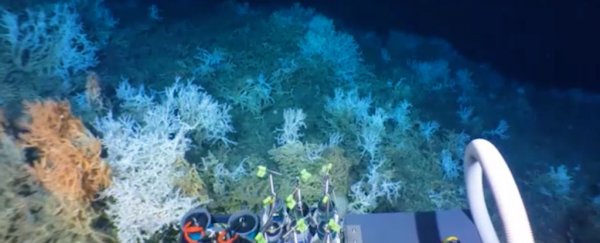Humans have been regularly traversing the Atlantic Ocean for going on six centuries, establishing the most efficient trade routes to haul people and goods, sharing details of the best places to pick up the speediest winds, occasionally using radar and satellites to thread a plane through a Category 5 hurricane.
But for all our knowledge of how to get over the Atlantic, we still know decidedly little about what, exactly, is beneath it.
Exhibit A, it would seem, is a discovery made this week 160 miles (260 kilometres) off the coast of Charleston: An enormous series of coral reefs that, combined, are nearly the length of Delaware.
Scientists say it may have been growing on the ocean floor for as long as modern humans have been on the planet.
"This finding changes where we thought corals could exist off the East Coast," Erik Cordes, a Temple University biology professor and the expedition's chief scientist, told The Washington Post.
"And the function of the reefs, in terms of recycling nutrients, is critical to fuel surface productivity and the fisheries we rely on.
"This discovery is already changing our predictive models for corals, This will undoubtedly lead to new discoveries in the region once we can digest all of the information. That will take months to years."
The find is about more than just raw science. The Trump administration wants to allow the energy industry to drill offshore, and researchers hope to be able to tell policymakers which areas should be off-limits.
The find was made as part of DEEP SEARCH, a five-year project to explore the sea off the coast of Virginia, North Carolina and South Carolina, according to its website, "including deep-water coral reefs and mounts, massive submarine canyons, and cold-seep communities that rely on the energy from natural gas rather than sunlight to fuel productivity."
Scientists with the National Oceanic and Atmospheric Administration, the Bureau of Ocean Energy Management, and the US Geological Survey are on a 15-day sea voyage aboard the research vessel Atlantis.
They make almost daily trips to the sea floor aboard a specially-equipped submersible named Alvin.
Their curiosity was piqued by something found a month ago by researchers on the vessel Okeanos: mounds of what turned out to be coral debris, with living coral growing along the top edge.
"We thought that the structure would mostly be rock, and hopefully with live coral cover on top," Cordes told The Washington Post.
They "never dreamed we were looking at structures created almost entirely of coral building up over thousands, or even hundreds of thousands, of years.
"We have yet to find a single rock on any of these features. Just coral for miles and miles."
Video posted by the Woods Hole Oceanographic Institution captured details of the dive in a time lapse. At first, small pieces of coral dotted the seafloor.
But, over time, large pieces of living coral can be seen, some of it snatched up by the submersible's arms and placed into sample containers.
The discovery comes as the Trump administration has proposed rolling back bans on ocean drilling. The move would reinstate offshore drilling leases, and has been publicly opposed by more than 140 municipalities.
In January, the Trump administration unveiled a plan that would permit companies to drill in waters on the US continental shelf, including protected areas of the Atlantic and Arctic oceans.
The Bureau of Ocean and Energy Management has identified 47 potential areas where industry companies can buy leases between 2019 and 2024, when the proposed period would begin and end, according to The Washington Post's Darryl Fears.
It's still unclear where industry insiders would want to drill and BOEM studies help determine which areas are most vulnerable, officials said.
Cordes told The Post that the reef appears to be one of those areas.
"The goal of this whole project is to discover new, fragile habitats and make them priorities for BOEM's management plan for the area in case it is opened up to drilling," he said.
"It is critical that we know where these places are, or they could be drilling right on top of a coral reef that no one knew was there."
2018 © The Washington Post
This article was originally published by The Washington Post.
